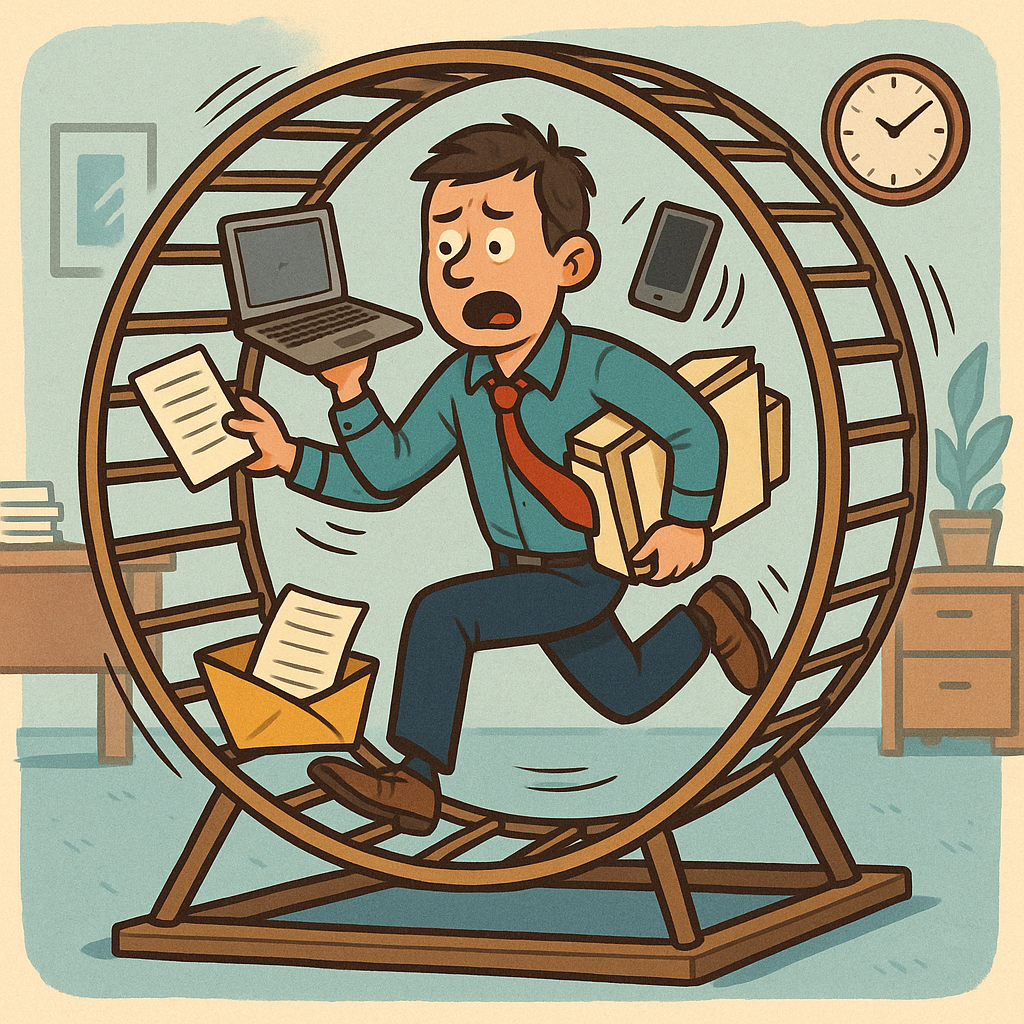It’s easy to feel exhausted yet stuck—answering emails, hopping meetings, juggling tasks. But being busy but not moving forward means you’re stuck in motion without direction—and that’s a trap waiting to happen.

1. You’re drowning in activity, but your to-do list never shrinks
Start by tracking your daily tasks. If you’re overwhelmed with activities yet core goals are untouched day after day, you’re likely caught in the busy but not moving forward loop.
- A Time Etc. study showed 43% of professionals never finish their daily lists—even when they clock over 40 hours per week.
- Getting buried in admin tasks (emails, scheduling, status reports) leads to busyness, not impact .
When administrative noise drowns mission-critical work, busyness has become a distraction, not a tool.
2. Task masking: Doing work that looks like work
Termed “task masking,” this trend involves behaviors that appear productive but aren’t advancing results.
- FT notes that Gen Z often imitates busyness—keeping their laptops open or mimicking stress—rather than doing purposeful work.
- Investopedia warns that “fake meetings” or excessive emailing are signs of effort without impact.
If your day is full of meetings and memos but lacks output, you’re in productivity theater.
3. That nagging exhaustion—mental fatigue without achievement
Constant task switching drains your brain’s resources. According to the World Economic Forum, multitasking triggers brain bottlenecks and weakens attention.
- “Your brain lacks capacity to concentrate on two things at once”—so scattered busyness kills progress.
- EMI ResearchGate study: busyness & multitasking reduces productivity no matter how much time you spend.
If you’re mentally drained but feel like you’ve been “working,” you may just have attention fatigue—not progress.
4. Toxic productivity and busyness as status
We’ve all felt the pull to glorify busyness—sensed it’s somehow cool. Yet doing nothing meaningful for appearance is harmful.
- Verywell Mind: People use busyness to boost self-worth, but over-scheduling harms health and relationships.
- HBR cautions against equating busyness with productivity—it often masks low creativity and results.
Rushing through tasks for credibility? That’s toxic productivity—not performance.
5. Boreout: Stretching nothing into everything
A reverse phenomenon—boreout—occurs when employees have nothing meaningful to do yet appear overwhelmed to avoid scrutiny.
- Wikipedia: People prolong tasks excessively, fill time with distractions so they seem busy.
- It’s not inertia—it’s anxiety: when there’s no challenge, employees imitate busyness to shield themselves .
If your tasks feel pointless but your calendar is full, you’re likely cultivating busyness out of fear—not forward movement.
6. The busyness matrix: Audit for real value
One way to untangle the trap is through a Busyness Matrix:
| Quadrant | Task type | What to do |
|---|---|---|
| Irrelevant / Meaningless | Social media, junk emails | Eliminate |
| Irrelevant / Meaningful | Passion projects that don’t align | Pause |
| Relevant / Meaningless | Low-impact meetings | Delegate or limit |
| Relevant / Meaningful | Core strategic work | Prioritize, protect time |
A week-long audit can reveal where your busyness is hiding. Focus on eliminating or delegating tasks in the first three quadrants.
7. Three practical strategies to regain momentum
A) Timebox & batch tasks deliberately
Use timeboxing—block clear windows for different work types:
- Management (emails/meetings)
- Creation (deep work)
- Ideation (thinking, planning)
This prevents leaking focus into pointless busywork.
B) Schedule focused breaks and downtime
Downtime isn’t wasted—it’s essential.
- Time experts at New America Foundation: creativity thrives when work alternates with rest.
- MIT Sloan: employees who unplug fully are more likely to earn promotions.
You can’t build progress without pauses that let your mind recharge.
C) Focus on outcome-based goals
Shift from “how busy I am” to “what did I achieve today?”
- Define 2–3 key outcomes for each week.
- Ask in every meeting: “What result are we aiming for?”
- Avoid default attendance—if you don’t add value, skip it.
Productivity is not motion; it’s direction. Define that direction.
8. Warning signs you’re stuck in busyness
- You frequently feel busy yet end-of-day satisfaction is low.
- Your calendar is full but strategic tasks are always shifted.
- You equate long hours with success and guilt-trap yourself for breaks.
- You engage more in reactive tasks (emails) than proactive work.
- You handle administrative tasks in time meant for key deliverables.
Presence doesn’t equal performance. Awareness starts the shift.
9. How modern dynamics amplify this issue
- Remote work: Screen-presence becomes the metric, encouraging “productivity theater”.
- AI anxiety: With fear of being replaced, many replicate busyness to signal relevance .
- Tight job markets: Gen Z in particular feels pressured to show effort—even if results lag.
These pressures make busyness feel like a shield—but it undermines sustainable progress.
10. A step-by-step action plan
- Audit a week of time—itemize tasks and label them in the Busyness Matrix.
- Set weekly outcome goals—2–3 measurable results.
- Timebox your calendar—batch emails, meetings, deep work, ideation.
- Say “no” strategically—skip or defer tasks that don’t support your goals.
- Schedule real breaks—fully unplug, walk, or rest—no devices.
- Review weekly—did tasks drive those outcomes? Adjust next week’s plan.
Rinse and repeat until busyness supports progress, not blocks it.
Conclusion
Being busy but not moving forward is a blindspot many talented professionals face today. The noise, the pressure, the schedules—they can trap you in motion without meaning. But progress comes when you define results, audit your activity, and choose focused, intentional work over busywork. Reclaim your time, restore your energy, and start moving forward—purposefully.
References
Sandhu, G. (2025). The Illusion of Productivity: Why You Are Busy But Not Moving Forward. Retrieved from Gurleen Sandhu website. https://gurleensandhu.com
Bloom, S. (2024). “Why You’re Always Busy but Never Productive (and How to Fix It).” Nir And Far. https://www.nirandfar.com
Waytz, A. (2023). Beware a Culture of Busyness. Harvard Business Review. https://hbr.org






